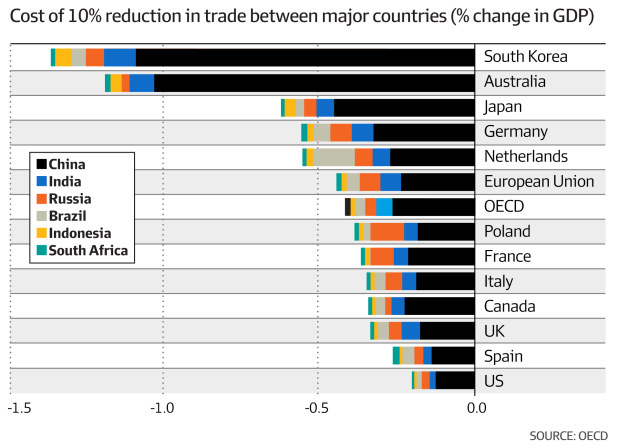...and with Trump, US-China trade war and antagonism is sure to be intensified.
Australia among biggest losers if US-China trade war flares
John KehoeEconomics editor
May 27, 2024 – 3.00pm
Australia would suffer the second-largest national income fall in the world if global trade tensions with China worsen and countries try to manufacture more at home, the Organisation for Economic Co-operation and Development has warned.
The alert comes amid the Albanese government’s multibillion-dollar bets to produce solar panels and batteries locally in an effort to be less reliant on China.
US presidential candidates Joe Biden and Donald Trump are pledging to ramp up tariffs on Chinese electric vehicles and bans on Chinese technology ahead of the election in November.
Australia’s $48 billion of education exports are also set to be hit by a crackdown on foreign students by the government and Coalition, a move expected to be raised by Chinese Premier Li Qiang on a visit to Canberra next month.
In a new report, the Paris-based OECD said Australia’s economic output would fall by about $30 billion (1.2 per cent of GDP) if there was a 10 per cent reduction of all bilateral goods and services trade flows between major economies.
Australia’s heavy dependence on China for mining exports and imports of manufactured goods left it only behind South Korea as the most exposed to a global trade slump.
Supply chain disruptions during the pandemic and geopolitical tensions have prompted politicians around the world to identify potential vulnerabilities related to critical trade dependencies.
Western economies – Australia, the US and European nations – are trying to “de-risk” trade by diversifying away from China to other trade partners and producing more products onshore.
“With global production becoming increasingly concentrated at the product level, it’s more important than ever that the debate on ‘de-risking’ international trade carefully considers the possible costs and benefits of different policy choices,” the OECD said.
“There is an economic cost to reducing trade between OECD and MNOE [major non-OECD economies] countries due to the relatively high degree of trade interdependencies between the two groups.
“OECD countries in the Asia-Pacific, in particular Korea and Australia, are affected the most. This is due to their relatively strong intermediate and final product linkages with MNOEs, particularly China, but also Indonesia and India.
“For a big exporter of agricultural and mining products, like Australia for example, the impact of the shock can be attributed to a very significant
extent (60 per cent) to the disruption of trade (mainly exports) of primary products.”
Mining highly vulnerable
Less global trade would lead to production declines in most sectors across the world, particularly mining, chemicals and motor vehicles, as demand for the goods fell.
“The fall in mining sector output is predominantly accounted for by the changes in mining production in Australia, where about half of its exports are destined for China,” the OECD said.
Its warning helps explain why Australia’s biggest miner, BHP, has consistently argued for free trade across the world, amid tensions between the world’s two largest economies, the US and China.
About 80 per cent of Australia’s mining exports are shipped to China.
Despite trade restrictions imposed by Beijing during the Morrison government’s tenure, China is Australia’s largest two-way trading partner, accounting for $317 billion or 26 per cent of Australia’s goods and services trade with the world in 2022-23.
Exports to China, mainly iron ore, coal, gas and tourism, totalled $204 billion.
The Albanese government’s Future Made in Australia policy has been partly justified by seeking to become less reliant on China for items such as solar panels.
Taiwan war risk exposes trade routes
The Productivity Commission’s Vulnerable Supply Chains report in 2021 in the wake of the pandemic found that of 6000 imported products from overseas, 199 were “vulnerable” items – about 3 per cent – came from China that couldn’t be easily sourced from elsewhere.
This included some chemicals, metal, machinery, equipment and personal protective equipment. Solar panels weren’t identified in the report.
In a separate report, Australian Strategic Policy Institute (ASPI) senior fellow David Uren identified the trade routes that are vital to Australia’s economic security in the event of conflict in Asia, such as over Taiwan.
“About two-thirds of Australia’s maritime exports and 40 per cent of its imports have to transit the narrow straits of Indonesia which would be an obvious choke point for trade in any conflict between China and the United States,” Mr Uren wrote last month.
“Any blockage of those straits in a conflict could force not only West Australia’s mineral exports, but also most of Europe and the Middle East’s trade with Asia to detour 10,000 kilometres around the south of Australia and across the Great Australian Bight before heading north up the Australian east coast.”
While the trade routes through Indonesia are the most vulnerable, a further 25 per cent of exports and 40 per cent of imports go around the eastern tip of Papua New Guinea before heading to Asia through the South Pacific.
The ASPI report called on the government to establish contingency plans for providing war-risk insurance to shipping traversing conflict zones and for emergency chartering of shipping capacity.
- Forums
- ASX - General
- Its Over
...and with Trump, US-China trade war and antagonism is sure to...
-
- There are more pages in this discussion • 1,723 more messages in this thread...
You’re viewing a single post only. To view the entire thread just sign in or Join Now (FREE)





